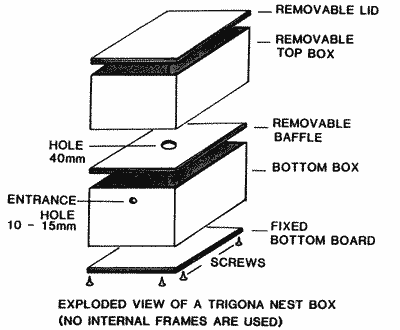
AUSTRALIAN NATIVE BEES
The best known of our native bees are the Trigona species, usually referred to as either trigona or stingless bees. They occur along the coastal and subcoastal areas of eastern Australia as far south as Sydney, with the tropical regions having the most species.
It is estimated that there are over 1600 species of native bees in Australia. Most are solitary, working and nesting as individuals. Some build nesting burrows in groups, but real social development is rudimentary.
STINGLESS BEES
HABITS
Only the stingless bees (Trigona spp) have a highly developed social structure in any way similar to that of honey bees. They are small grey-black bees about 4mm long and all carry pollen on their hind legs in the same manner as honey bees. As their name implies, they are incapable of stinging although they do possess a small ineffective sting. They can, however, annoy an intruder by flying into the eyes, ears and nose. Sometimes they are called 'sweat bees' as a result of their habit of licking perspiration from the hands, arms and face of people handling them.
Nesting sites vary, but hollow branches or dead tree trunks are common. Nests are usually difficult to locate, but as these bees only work 400 to 500 m away from their nests, intense activity on flowers is a good indication that nests are nearby. The nest consists of bees (workers, drones and a queen), cells to store nectar and pollen and other different cells to rear brood. Queen cells are much larger than other brood cells. It is uncommon to find more than 1 kg of honey in a nest. Their honey is usually dark, thin and sweet. In log hives it is difficult to remove the honey without destroying the nest.
The entrances to the nest vary with the species. For example, in T. australis, the entrance has an externally projecting tube which is closed off at night and during adverse conditions. With T. carbonaria, the nest entrance has no external tube and the entrance remains open throughout the year.
A new Trigona nest is established over a period of time with food and materials supplied by the parent nest, unlike honey bee colonies which rely on the swarming habit. A young queen is raised in the parent nest and moves to the new nest.
In some areas, particularly in North Queensland, Trigona bees occasionally harvest areas of new paint. This habit can be rather annoying but is seldom of significance except when several colonies are nesting quite close to the freshly-painted area.
RELOCATING NESTS
Trigona are beneficial native insects and are best left undisturbed unless the nest is in danger of destruction.
Where this is the case or where we may wish to relocate the nest for other reasons, it can be removed by cutting off the section of the log containing it.

Often it is only a metre long. The log section should be transported to its new site at night. Although Trigona cannot be kept in a frame hive like honey bees, they can be transferred to a wooden box. A hive about 30 cm wide, 40 cm long and 30 cm high made from 1 or 2 cm thick timber or plywood with an entrance hole of 10 to 15 mm located in the lower front is suitable. A fixed bottom and removable lid of similar material are necessary.
An adaptation of this style of hive is two boxes, 20 cm high. Between the boxes is placed a board similar to the lid but having a 4-cm hole in the centre. The bushnest should be placed into the lower box as intact as possible and without leaving spilt honey in the box. The bees then build a dark-coloured shell of propolis-like material in the box. The bees tend to reserve the lower box for brood. Honey cells are built over the interior of the top box. Observation inside the lower box is not possible without damage to the nest.
SOLITARY BEES
Two native bees often seen in the orchard and garden are the bluebanded bee (Amegilla pulchra), and the large carpenter bee or native bumble bee (Xylocopa bryorum).
BLUEBANDED BEE
This bee is about 12 mm long and distinguished by four blue bands on the abdomen. It is a solitary species, that is, each female bee works by itself collecting pollen and taking it back to its individual nesting site, usually a hole in soft earth. Several nests are often found in the same area, giving the appearance of social behaviour. However, each nest hole is separate and leads to the nest of an individual female.
CARPENTER BEE
This bee is very conspicuous. It is about 40 mm long with an abdomen varying from brown to black and bright yellow thorax. It makes a loud buzzing noise when flying and can frequently be seen visiting male pawpaw tree flowers early in the morning. It is a solitary bee that drills a large nest hole in dead, dry wood to rear its young.
POLLINATION
Native bees play a role in the pollination of a wide range of plants. Among the many native trees and shrubs which attract large numbers of native bees are Callistemon (bottle brush), Cassia, Eucalyptus (gums), Leptospermum and Melaleuca (tea trees). Additionally, they collect pollen from many of our imported crop plants and undoubtedly help in pollination.
Crops which appear more attractive to native bees than to honey bees are pawpaw, passionfruit, granadilla, mango and grape.
DATE: January 1993
* * * * * * * * * * * * * * *
